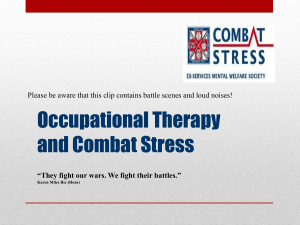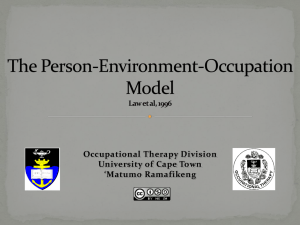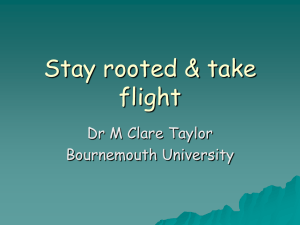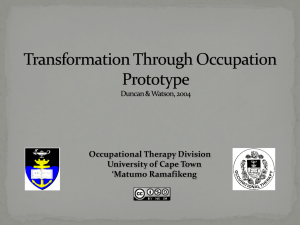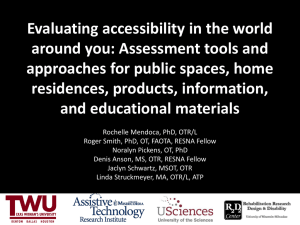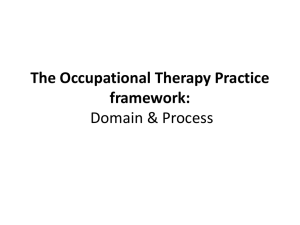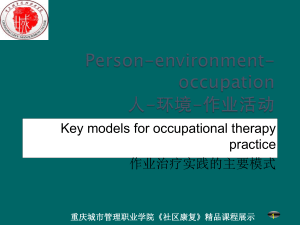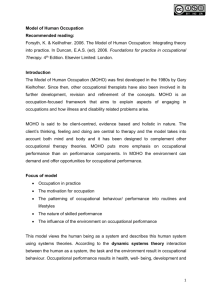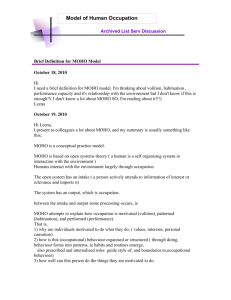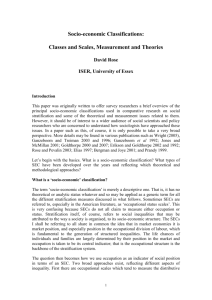CMOP-E
advertisement
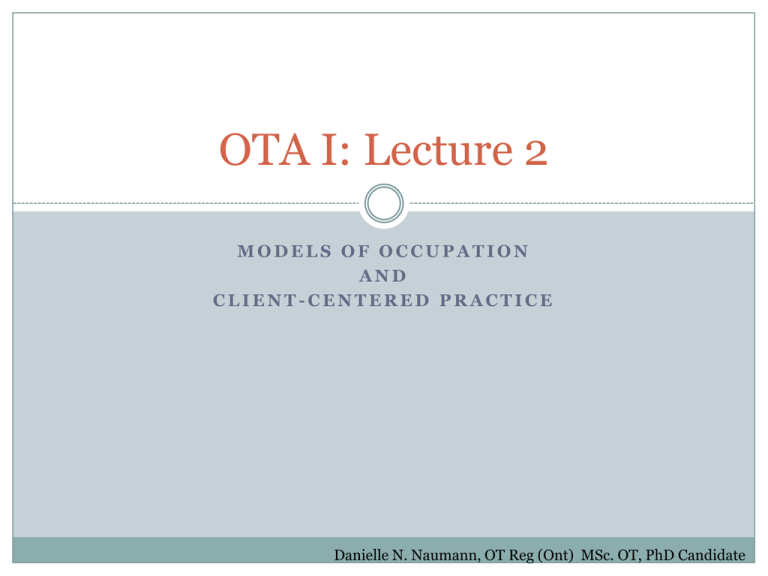
OTA I: Lecture 2 MODELS OF OCCUPATION AND CLIENT-CENTERED PRACTICE Danielle N. Naumann, OT Reg (Ont) MSc. OT, PhD Candidate Overview Discussion of Readings Discussion of Activity Log Review Occupation Models of Practice in OT PEO (Lab Activity #1) CMOP-E MOHO Kawa Model Client Centered Practice Analyzing Occupational Performance Canadian Occupational Performance Measure Lab Activity #2 Readings Chapters 1-4 in Early Text History of Occupational Therapy Assistants in Canada Discuss: Questions? Comments? Impressions? Strategies for exam preparation… Discuss… Questions? Comments? Impressions? Activity Logs Thoughts on the process? Discuss what you found: Are you doing the most important work at the right time of day for you? How much of your time spent on Leisure Productivity Self-care Are you wasting time? Any personal revelations to share? Key features of Occupation Occupation is a: Basic human need Determinant of health Source of meaning Source of purpose Source of choice and control Source of balance and satisfaction Means of organizing time Means of organizing materials and space Means of generating income Descriptor Therapeutic medium Occupation and Physical Dysfunction Occupation is defined as: The ordinary and familiar things that people do every day. The ability to pursue and perform a person’s customary occupations is taken for granted so long as a person is well. Injury and disease may disrupt occupation temporarily, but most people seek or are referred for the services of an OT only when they encounter significant difficulty resuming or enacting (carrying out) occupations that are important to them. Models of Practice in OT Person Environment Occupation Performance Model (PEO) (Charles Christiansen & Carolyn Baum) Occupational Performance Model (OPM) Canadian Model of Occupational Performance and Engagement (CMOP-E) (CAOT, 1997) Model of Human Occupation (MOHO) (Kielhofner) Kawa (River) Model (Michael Iwama) Person-Environment-Occupation Model Dominant Canadian model Occupational Performance is the intersection of factors of the person, environment and occupation Person: personal factors that allow or limit performance Environment: factors in the environment that allow or limit performance Occupation: factors in the task or activity that allow or limit performance PEO Model Person-Environment-Occupation Person: Dynamic, motivated, ever-developing, constantly interacting with the environment Individual attributes that can change, influence interactions with environment and approach to occupational performance Environment: The context, influences behavior and is influenced, is not static and is easier to change then the person Occupation: Purposeful activities that meet intrinsic needs for self-maintenance, expression, and fulfillment Occupational Performance: Complex, dynamic phenomenon, shaped by PEO factors Person-Environment-Occupation Fit: The closer the overlap, the more harmonious the interaction Greater compatibility= more optimal occupational performance PEO Model Source: Law et al. 1996 PEO Model: Implications for Practice Consideration of interventions that target different problem areas of the Person, Environment, and Occupation Multiple avenues for eliciting change Use more instruments to elicit change and understand the context of the occupational performance issue Lab Activity 1: In pairs (and one group of 3): 15 minutes to: Review materials on a model of occupation MOHO CMOP-E KAWA Model Answer 4 questions on the model of occupation Discuss case study in light of this model of occupation 5- minute presentation to the class key features of the model of occupation case study explain the model Lab Activity 1 What are the key points of the model? 1. 1. Summarize the model 2. Explain the visual model 1. Tell us how it works visually 3. How is it different from the PEO model? 4. What does it add to the OT perspective? 1. Implications for practice CMOP-E Canadian Model of Occupational Performance and Engagement (CMOP-E) CMOP states that OP is the result of a dynamic relationship between persons, environment and occupation over a person’s lifespan. OP refers to the ability to choose, organize, and satisfactorily perform meaningful occupations that are culturally defined and age appropriate for looking after one’s self, enjoying life and contributing to the social and economic fabric of a community. CMOP-E OT theory, research and practice showed that OP performance is not static as the circle implied. Therefore recently added Engagement to the model OP is the result of an interdependent and changing person-environment-occupation relationship This dynamic interaction occurs among people, their occupations and roles, and the environment in which they live, work, and play over the lifespan CMOP-E provides a framework for enabling occupations for all persons. CMOP-E Change in any aspect of the model would affect all other aspects CMOP highlights the focus on occupation Spirituality is embedded as a core in all parts of person-environment-occupation interactions. Spirituality resides in the persons, is shaped by the environment, and gives meaning to occupations. Conveys client-centered perspective Diagram of the MOHO Model of Human Occupation Gary Kielhofner Based upon different areas of knowledge Systems theory Cognitive psychology Developmental psychology Humanistic psychology Social psychology OT roots of the model stem from Mary Reilly “Man, through the use of his hands as they are energized by mind and will, can influence the state of his own health.” Key Assumptions of MOHO Human organism is an open system Occupations are central to human experience, survival and satisfaction. Occupational areas of work, self-care, and play evolve and change throughout the lifespan. People seek to explore and master their environments. Environment affords opportunities and presses for performance. The individual’s perceptions of feedback from the environment are crucial in directing further output of adaptive occupational performance. OP results from interaction of 3-subsystems: Volition (will) – the mechanisms whereby we choose what to do Habituation (roles and rules) – the basic cognitive structures with which we organize our lives. Mind-body-brain interactions (skills) – the means by which we carry out occupational behaviour. Ways in which the human system is able to change adaptively: New behaviour established by repetition Change can be produced by alterations within the organization of the internal system or by changes that occur outside the system. Change can be dramatic Small changes are important Human system continually changes and adapts: “the organization at any point in time is a reflection of the dynamic process of life.” Influence of Environment on the individual: “Press” is the demands the environment places on an individual for appropriate occupational behaviours Environment contains things which are capable of arousing us and promoting action (objects, tasks, social groups, cultural pressures) Novelty and stimulation to a degree is pleasurable and promotes exploration and master. People generally perform well in such conditions. Too much “press” can result in stress, anxiety, uncertainty, helplessness, frustration, anger or inability to cope. People generally fail to perform in such environments. Too little “press” results in apathy, withdrawal and disinterest, in which circumstance people also fail to perform well. MOHO applies to all aspects of OP Not just the physical Altering environment to elicit a change in OP is a key principle of MOHO. Purposeful alteration of the physical setting (ex. Adding a ramp) Providing a new object (reacher to grasp objects) Providing or facilitating a change in social groups (ex. Training a caregiver to break down and cue a sequence such as brushing teeth) Arranging the client to experience new occupations (ex. Using a computer to access the internet for a client who has always handwritten letters) Kawa (River) Model Break! See you all back at 12:30 Client Centred Practice Client as expert Family vs. client centred care Client centred goal setting Why is this important? Analyzing Occupational Performance When physical generally obvious deficits in performance components Important to continue to focus on the occupation as a whole not focus only on specific deficits. Therapist is required to look at the bigger picture of occupational functioning; the specific and highly individual functioning desired /required for that individual in his or her chosen and valued occupations. Obtaining Information about OP Assessed by: self-report, family/caregiver report and skilled observation Client asked to identify problems, needs and priorities Information gained through clinical interview skills and use of therapeutic rapport. Two examples of assessments to gain information about OP: Interview-based assessments (ex. COPM) Performance-based assessments Direct observation of the client performing activities that are difficult for them and that they have identified that they want to be able to do again Canadian Occupational Performance Measure (COPM) Interview based assessment Structured interview format Allows practitioner to cover all necessary areas Rating system provides score for reassessment Lab Activity #2 COPM interview Interview your partner Partner can assume a personality/condition Go through rating scheme together
